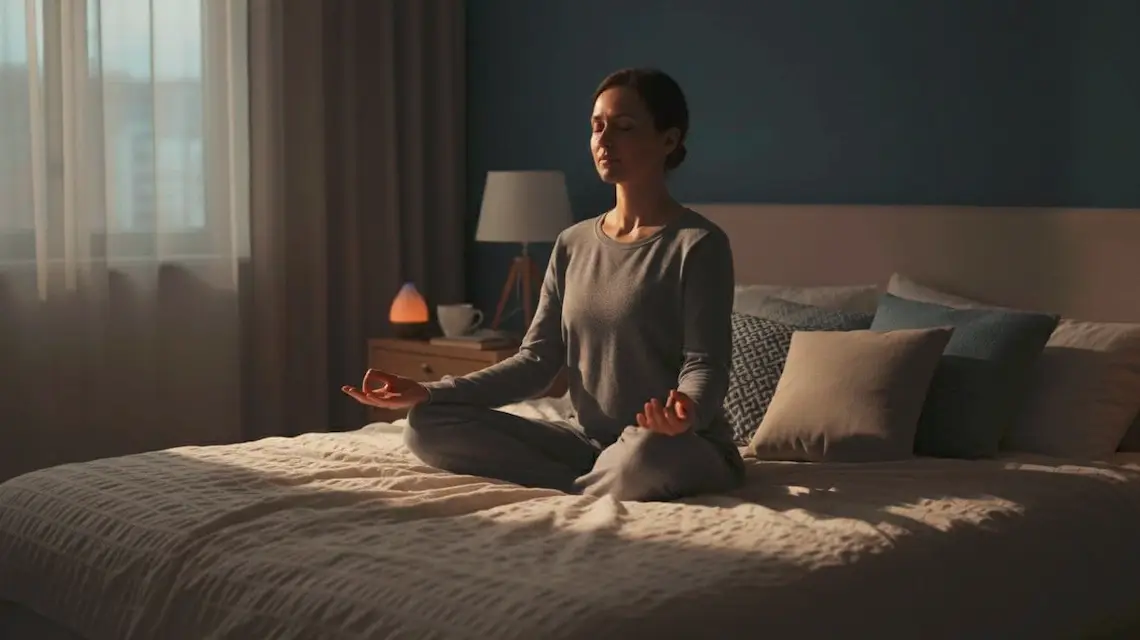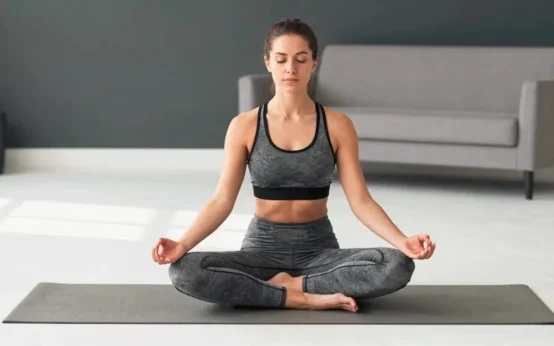Nights feel long when your brain will not slow down. You toss, you turn, you check the clock, and your thoughts race. If this sounds familiar, you are not alone.
Insomnia means trouble falling asleep, staying asleep, or waking too early and not getting back to sleep. It can show up during a stressful week or linger for months. The good news is you can train your body and mind to settle. Sleep meditation techniques for fighting insomnia naturally help calm your nervous system, slow your breath, relax tense muscles, and quiet mental chatter.
Here, you will learn how these practices work, exact techniques you can try tonight, how to build a steady routine, and what to do when insomnia fights back. No pills. No pressure. A small daily practice builds results in one to two weeks. Let’s start simple and keep it doable.
How sleep meditation calms insomnia, in simple science
When stress rises, your body flips to alert mode. Heart rate climbs, breathing speeds up, and the mind loops on what-ifs. This is the arousal response. It keeps you safe in danger, but it also blocks sleep when it sticks around at bedtime.
Meditation interrupts that cycle. Slow breathing lowers heart rate and blood pressure. Body relaxation reduces tension. Focused attention gives your mind a simple job, which reduces worry spirals. You move from fight or flight toward rest and digest.
It also helps the brain. The worry center quiets, and areas that guide attention get stronger. Over days of practice, you notice fewer thought loops and quicker recovery when stress pops up at night.
Set your expectations. Try 10 to 20 minutes most nights. Progress often feels slow at first, then clear by the second week. Most people find meditation safe and gentle. If you have severe anxiety, trauma, or sleep apnea, talk with a professional before you start.
What triggers sleepless nights: stress, arousal, and thought loops
Common triggers include:
- Late caffeine or energy drinks
- Bright screens at night
- Worry about tomorrow
- Pain or discomfort
- An irregular sleep schedule
- Heavy talks at night
- A hot room or loud space
Think of your brain like a car engine idling too high. Even when you are tired, the system stays revved. Meditation acts like a gentle foot on the brake, helping the engine settle to a calm idle.
Why meditation helps sleep: lower arousal, relax the body, focus the mind
Here is the simple chain:
- Slow exhales tell your body it is safe.
- Relaxed muscles send a calm signal back to the brain.
- A soft focus gives your mind a single task, so worries fade into the background.
Breath, body, and attention work together. When you guide these three, sleep follows more easily.
Set real goals so you stick with it
Choose goals that feel concrete:
- Fall asleep 10 minutes faster
- Wake fewer times overnight
- Feel calmer while lying in bed
Give it 14 days. Aim for practice, not perfection. Progress is rarely a straight line, so celebrate small wins, like fewer worries or a smoother wind down.
Step-by-step sleep meditation techniques for fighting insomnia naturally
Use these scripts during your wind down or while in bed. Keep them simple, 5 to 15 minutes. Breathe through your nose if you can. If your mind wanders, return to the step without judgment.
Box breathing and 4-7-8 breathing to slow your heart
Two options, both reliable:
- Box breathing
- Inhale for 4.
- Hold for 4.
- Exhale for 4.
- Hold for 4.
- Repeat for 2 to 5 minutes.
- 4-7-8 breathing
- Inhale through your nose for 4.
- Hold for 7.
- Exhale through your mouth for 8, soft and quiet.
- Repeat 4 to 8 rounds.
Tips: relax your jaw, drop your shoulders, and let your belly rise on the inhale. If you feel lightheaded, shorten the counts. Comfort matters more than perfect timing.
What to notice: the cool air on the inhale, the warm air on the exhale, your ribcage moving. If thoughts jump in, label them, thinking, then return to the next count.
Body scan with gentle release from head to toe
Settle on your back or side. Hands rest at your sides or belly.
- Start at your forehead. Notice any tightness. On a slow exhale, soften the area. Imagine warm weight melting across your brow.
- Move to your eyes and jaw. Unclench. Let your tongue rest.
- Scan your neck, shoulders, and upper back. Drop the shoulders on the exhale.
- Move through your arms, hands, and fingers. Loosen your grip.
- Move to your chest and belly. Let the belly expand on the inhale.
- Scan your hips, thighs, knees, calves, and feet. Release each area with a slow exhale.
Take 8 to 12 minutes. If you lose your place, restart at the head, or jump to your feet and work upward. If your mind wanders, that is normal. Return to the next body part. Keep the tone gentle, not forced.
Guided imagery: build a calm sleep story your brain trusts
Pick a place that feels safe and familiar. A quiet beach. A library. A garden at dusk.
- Picture the scene in soft detail.
- Use all five senses:
- Sight: the color of the sky, shadows, or shelves of books.
- Sound: waves, a distant fan, or leaves brushing.
- Touch: warm sand, a soft chair, or cool air on your skin.
- Smell: salt air, paper, or lavender.
- Taste: a hint of mint tea or fresh air.
Keep the scene steady. No action, no decisions. Ride the breath like gentle waves. If worries pop up, label them, thinking, and return to one sense in the scene.
Stay for 5 to 15 minutes, or let the scene carry you into sleep.
Mantra or counting meditation to quiet the chatter
Give your mind a simple anchor.
- Pick a phrase: I am safe, or I can rest.
- Or count breaths from 1 to 10, then start over.
Sync the mantra or the count with your exhale. If a thought grabs you, return to the next number or word. Aim for 5 to 10 minutes. Keep it kind and light.
Build a bedtime routine that makes meditation work every night
Habits carry you when willpower is low. A steady routine trains your brain to power down on schedule. Plan a 90 minute wind down, set a consistent sleep window, and place meditation in that flow.
The 90 minute wind down: light, screens, and simple habits
Create a gentle sequence that repeats most nights:
- Eat a light dinner and finish at least 2 to 3 hours before bed.
- Take a warm shower to cue a drop in body temperature.
- Do light stretching or a few yoga poses.
- Journal three worries with next steps. Close the notebook.
- Sip herbal tea without caffeine, like chamomile.
- Dim lights and switch devices to night mode, or put the phone away.
- End with 10 minutes of one chosen meditation from this guide.
Keep the tone quiet. No news. No heavy talks. Protect this time like you protect your morning coffee.
Shape your sleep space: dark, cool, and quiet
Small fixes can make a big difference:
- Keep the room cool, about 65 to 68°F.
- Use blackout curtains or a soft eye mask.
- Pick simple, breathable bedding.
- Try a fan or white noise if sounds wake you.
- Turn the clock face down to stop clock watching.
Your room should whisper, sleep lives here.
When to meditate and for how long, including 2 a.m. wakeups
- During wind down: practice 10 to 20 minutes, then get in bed.
- If still awake after 20 to 30 minutes in bed, sit up or leave the bed and do a mini session. Try 5 to 10 minutes of slow breathing or a body scan in a chair. Return to bed when sleepy.
- Keep lights low and movements calm. Avoid bright screens.
Track progress with a simple sleep diary and adjust
Use a basic note on your phone or a small notebook:
- Time you got in bed and time you woke up
- How long it took to fall asleep
- Number of wakeups
- Which technique you used
Review after one to two weeks. Keep what works, drop what does not. Aim for small, steady gains, like falling asleep faster or feeling calmer at night.
Troubleshooting and FAQs: when insomnia fights back
Insomnia can be stubborn. That is normal. Try shorter sessions, new positions, or a different technique. Be patient with yourself. The body learns with practice.
If your mind will not slow down: cognitive shuffle and worry time
- Cognitive shuffle: name random, simple objects at a slow pace, like apple, chair, cloud, spoon, ticket. Avoid themes or stories. The brain cannot build a worry chain when the items do not connect.
- Worry time: schedule 10 minutes in the evening to write your concerns and one next step for each. Close the notebook when the timer ends. If worries show up at night, remind yourself, I handled that during worry time.
Night wakings: mini meditations to fall back asleep fast
If you are awake for more than 20 minutes:
- Get out of bed and sit in a chair.
- Keep lights low.
- Do 5 minutes of 4-7-8 or a short body scan.
- Return to bed when your eyelids feel heavy.
Avoid scrolling or bright lights. They tell your brain it is morning.
Common blockers: caffeine, alcohol, pain, and blue light
Improve the ground so meditation can work better:
- Skip caffeine after early afternoon.
- Limit alcohol, it fragments sleep later at night.
- Treat pain before bed with your doctor’s guidance.
- Reduce blue light at night, dim screens or use night mode.
These small steps protect your sleep window and reduce arousal.
When to see a doctor or therapist for insomnia
Get help if sleep trouble lasts at least three nights a week for three months, or if you have loud snoring, pauses in breathing, or mood issues. Cognitive Behavioral Therapy for Insomnia, also called CBT-I, is a proven treatment that pairs well with meditation. A pro can help tailor these tools to your needs.
Conclusion
Rest is a skill you can practice. The core idea holds true. Sleep meditation techniques for fighting insomnia naturally work best when paired with a calm routine and steady daily practice.
Here is a simple 7 night plan:
- Pick one technique, like 4-7-8 or a body scan.
- Practice 10 minutes during your wind down each night.
- Log your sleep time, wakeups, and the technique.
- On night 4, review the notes and adjust the method if needed.
- Add a mini session if you wake at 2 a.m., 5 to 10 minutes, low light.
- Keep caffeine early and screens dim at night.
- Repeat for another week if you like the progress.
Choose the technique that felt easiest, and start tonight. Your nights can feel shorter, softer, and more predictable with a small practice you control.
Related post: How Long Does It Take to Cure Chronic Insomnia
FAQ:
What is sleep meditation, and how does it help insomnia?
Sleep meditation is a set of mind-body practices that calm the nervous system. It lowers arousal, eases stress, and reduces rumination. This helps your brain shift into a sleep-ready state.
Which sleep meditation techniques work best?
A few standouts:
- Body scan, relaxes muscles and reduces tension.
- Diaphragmatic breathing, slows heart rate and calms the mind.
- Mindfulness, trains nonjudgmental awareness and quiets worry loops.
- Guided imagery, uses soothing scenes to ease mental chatter.
- Progressive muscle relaxation, tenses then releases muscle groups.
- Yoga nidra or NSDR, guides deep rest while still awake.
How long should a session be?
Start with 10 to 15 minutes. Many people do well with 20 to 30 minutes. Short and daily beats long and rare.
When should I meditate for sleep?
Use it 30 to 60 minutes before bed, or in bed as you wind down. A brief afternoon session can also lower evening stress.
What breathing pattern is best for sleep?
Try 4-6 breathing. Inhale through the nose for 4 counts, exhale for 6 counts. Aim for 6 to 8 breaths per minute. Keep it gentle.
How do I do a simple body scan?
- Lie on your back, arms by your sides.
- Breathe slowly, eyes closed.
- Move attention from toes to head.
- Notice sensation, soften each area as you go.
- If thoughts pop up, return to the body part.
What if my mind races at night?
Name the thought, then return to the breath. Keep a notepad by the bed for a quick brain dump. Use a guided track to anchor attention.
I fall asleep during meditation. Is that OK?
Yes. If sleep is the goal, that is a win. If you want to build the skill, practice a short session earlier in the day while seated.
Do I need an app or can I do it alone?
Both work. Apps add structure, voice guidance, and timers. Once you learn the basics, a simple self-guided routine is enough.
Should I use headphones for guided sleep tracks?
Use low volume speakers if you share a bed. If you use headphones, pick soft, comfortable ones. Avoid high volume.
Are binaural beats or solfeggio tones helpful?
Evidence is mixed. Some people find them relaxing, others do not. If you try them, keep volume low and use them as a background aid, not a cure.
What position should I use?
Pick a comfortable position you can stay in without fidgeting. Back or side lying works well. Support knees with a pillow if needed.
Can meditation fix insomnia on its own?
It often helps, especially with stress-related insomnia. For chronic insomnia, pair it with sleep hygiene and, if needed, cognitive behavioral therapy for insomnia.
How long until I notice results?
Some feel calmer on night one. Lasting change takes 2 to 4 weeks of daily practice. Track your progress to stay motivated.
What should I do if I wake at 3 a.m. and can’t fall back asleep?
Stay in low light. Try 4-6 breathing or a short body scan. If wide awake after 15 to 20 minutes, get up and do something calm until sleepy returns.
Is 4-7-8 breathing safe?
Most healthy adults can use it. If breath holds feel uncomfortable, skip the holds and use 4-6 breathing instead. Pregnant people should avoid long breath holds.
Can I nap and still use sleep meditation at night?
Short naps are fine, 20 minutes before mid-afternoon. Long or late naps can disrupt sleep pressure.
How does mindfulness reduce insomnia?
It builds skill in noticing thoughts without getting pulled in. Less worry and reactivity means less nighttime arousal and easier sleep onset.
What role does the bedroom environment play?
Keep it dark, cool, and quiet. Use a fan or white noise if sounds wake you. Reserve the bed for sleep and intimacy.
Should I avoid screens before sleep meditation?
Yes. Blue light and stimulating content delay melatonin. Stop screens 60 minutes before bed, or use dim light and night mode if needed.
Is caffeine sabotaging my results?
Likely if used late. Cut caffeine after early afternoon. Watch hidden sources like tea, soda, pre-workouts, and chocolate.
How do I track whether it’s working?
Log bedtime, sleep onset time, night awakenings, total sleep time, and how you feel each morning. Review weekly to spot trends.
Can kids or teens use sleep meditation?
Yes, keep sessions short, 5 to 10 minutes. Use simple body scans, soft breathing, or kid-friendly stories. Caregiver guidance helps.
Is sleep meditation safe for pregnancy?
Gentle breathing, body scans, and guided imagery are safe. Skip long breath holds or hot rooms. Ask your clinician if you have concerns.
What if I have sleep apnea or snoring?
Meditation can reduce stress but will not treat airway issues. Get evaluated if you snore loudly, stop breathing, or feel unrefreshed.
Is it OK after trauma or with PTSD?
Some find eyes-closed practices triggering. Try eyes-open grounding, soft sounds, or guided practices that feel safe. Work with a therapist if needed.
Can supplements replace meditation?
No. Some people use magnesium or herbal teas, but evidence varies. Discuss any supplement with your clinician, especially if you take other meds.
What if I feel worse while practicing?
Stop the session, return to normal breathing, and open your eyes. Try a shorter track, or switch to a different technique. Seek guidance if distress continues.
What’s a simple nightly routine to try?
- Dim lights 60 minutes before bed.
- 5 minutes of light stretching.
- 10 to 20 minutes of guided body scan or yoga nidra.
- 5 minutes of slow nasal breathing.
- Lights out. If awake, repeat a brief breathing set.
When should I see a doctor?
Get help if insomnia lasts longer than three months, or if you have daytime sleepiness, mood changes, or suspected apnea. Professional care can speed progress.




 How to Meditate Properly: A Simple Guide
How to Meditate Properly: A Simple Guide  How To Remove Sun Tan From Hands
How To Remove Sun Tan From Hands  How Do You Do TM Meditation
How Do You Do TM Meditation  How to Take Care Your Nails
How to Take Care Your Nails  How to Improve Good Cholesterol (HDL)
How to Improve Good Cholesterol (HDL)  Hormone Health Tips for Women
Hormone Health Tips for Women